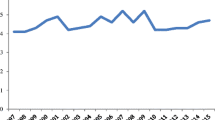Abstract
The raising trend both in violent and property crime are of major concern in Iran. Using a panel data modeling (province wide), the paper provides an econometrics assessment of the relationship between crime against properties and violent crimes as functions of deterrent, social, economic and demographic factors in Iran, in the framework of Becker-Ehrlich crime supply theory. The findings indicate that, although deterrence hypothesis is not confirmed for burglary and assault, it explains the variations of murders and threats. Economic factors play key role in burglary and threat explanation, but they do not affect willful murders, however, Literacy explains both murders and threats. Average of families’ income is explored as a deterrent factor for crime against properties.





Similar content being viewed by others
Notes
In situations which vector of \( {\mathbf{X}}_{it} \) consists a lag dependent variable, Arellano and Bond (1991) two stage procedure will be used.
Regressions are estimated by STATA 9.1 software.
References
Arellano, M., & Bond, S. (1991). Some tests of specification for panel data: Monte Carlo evidence and an application to employment equations. Review of Economic Studies, 58, 277–297.
Becker, G. S. (1968). Crime and punishment: An economic approach. The Journal of Political Economy, 76, 169–217.
Bourguignon, F. (2001). Crime as a social cost of poverty and inequality: A review focusing on developing countries. http://economia.uniandes.edu.co/revistadys/44/Articulo44_5.pdf.
Cameron, S. (1988). The economics of crime and deterrence: A survey of theory and evidence. Kyklos, 41(2), 301–323.
Cantor, D., & Land, K. (1985). Unemployment and crime rates in the post-world war II United States: A theoretical and empirical analysis. American Sociological Review, 50, 317–332.
Carmichael, F., & Ward, R. (2001). Male unemployment and crime in England and Wales. Economics letter, 73, 111–115.
Chiricos, G. T. (1987). Rates of crime and unemployment: An analysis of aggregate research evidence. Social Problems, 34(2), 187–212.
Cressman, R., Morrison, G. W., & Wen, J. F. (1998). On the evolutionary dynamics of crime. The Canadian Journal of Economics, 31, 1101–1117.
Ehrlich, I. (1973). Participation in illegitimate activities: A theoretical and empirical investigation. The Journal of Political Economy, 81, 521–565.
Ehrlich, I. (1996). Crime, punishment, and the market for offenses. The Journal of Economic perspectives, 10, 43–67.
Entorf, H., & Spengler, H. (2000). Socioeconomic and demographic factors of crime in Germany. Evidence from panel data of the German States. International Review of Law and Economics, 20, 75–106.
Fajnzylber, P., & Lederman, D. (2002). Inequality and violent crime. Journal of Law and Economics, XLV, 1–40.
Freeman, R. (1983). Crime and unemployment. In J. Q. Wilson (Ed.), Crime and public policy (pp. 89–106). San Francisco: Institute for Contemporary Studies.
Glaeser, L. E., & Sacerdote, B. (1999). Why is there more crime in cities? The Journal of Political Economy, 107, S225–S258.
Glaser, L. E., Sacerdote, B., & Scheinkman, A. J. (1996). Crime and social interactions. The Quarterly Journal of Economics, 111(2), 507–548.
Gould, E. D., Weinberg, B. A., & Mustard, D. B. (2002). Crime rates and local labor market opportunities in the United States: 1979–1997. The Review of Economics and Statistics, 84(1), 45–61.
Kelly, M. (2000). Inequality and crime. The Review of Economics and Statistics, 82, 530–539.
Paley, W. (1785). The principles of moral and political philosophy. Reprint, Whitefriars, London: T. Davidson, 1822.
Palmer, J. (1977). Economic analysis of the deterrent effect of punishment: A review. Journal of Research in Crime and Delinquency, 14(1), 4–21.
Pyle, D. (1983). The economics of crime and law enforcement. London: Macmillan.
Raphael, S., & Winter-Ebmer, R. (2001). Identifying the effect of unemployment on crime. Journal of Law and Economics, XLIV, 259–283.
Smith, A. (1776). The wealth of nations. Reprint, New York: Random House, 1937.
Statistical center of Iran. (1995–2005). Statistical Yearbooks.
Stigler, G. (1970). The optimum enforcement of laws. Journal of Political Economy, 78(3), 526–536.
Usher, D. (1997). Education as a deterrent to crime. The Canadian Journal of Economics, 30, 367–384.
Wong, Y.-C. R. (1995). An economic analysis of the crime rate in England and Wales, 1857–92. Economica, 62(246), 235–246.
Author information
Authors and Affiliations
Corresponding author
Rights and permissions
About this article
Cite this article
Keshavarz Haddad, G., Markazi Moghadam, H. The socioeconomic and demographic determinants of crime in Iran (a regional panel study). Eur J Law Econ 32, 99–114 (2011). https://doi.org/10.1007/s10657-010-9152-4
Published:
Issue Date:
DOI: https://doi.org/10.1007/s10657-010-9152-4




